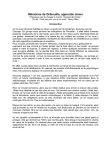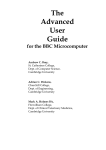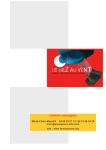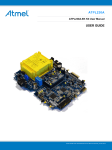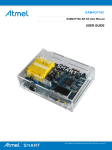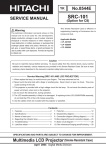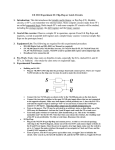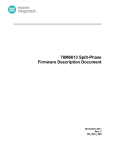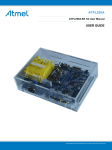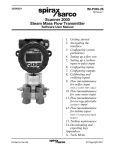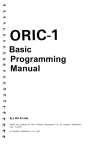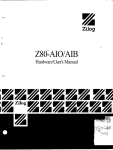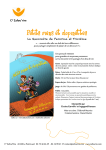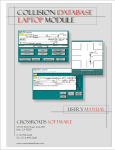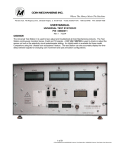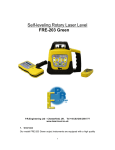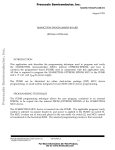Download ATPL Sidewise manual - Retro-kit
Transcript
AT PL ADVANCED TECHNOLOGY PRODUCTS LIMITED SIDEWISE USER MANUAL SECTION CONTENTS Page 1 - WHAT ARE SIDEWAYS ROMs? 2 2 - ROM FILING SYSTEM 2 3 - INTRODUCING SIDEWISE 2 4 - CONNECTION TO THE BBC COMPUTER 3 5 - BATTERY BACKED RAM OPTION 5 6 - LINK SELECTABLE OPTIONS 6 TABLE 1 8 SIDEWISE LAYOUT DIAGRAM 9 Station Road Clowne Chesterfield S43 4AB ENGLAND TEL: Chesterfield (0246) 811585 (4 lines) c p 1983 ATPL SECTION 1 – WHAT ARE SIDEWAYS ROMs? The BBC COMPUTER incorporates facilities whereby a number of applications programs may be resident in the machine in firmware, (e.g. ROM or EPROM memory) and which may be called upon by the user via the operating system to perform specific tasks such as word processing, floppy disc management and so on .The memory is organised in such a way that only one such SIDEWAYS ROM may be active at any instant in time and all communication between such ROMs must be performed via the operating system. Each SIDEWAYS RCM occupies the same physical area of the BBC COMPUTER memory map - namely 8000-BEFF HEX. SIDEWAYS ROMs therefore provide a convenient method of expanding the memory of the BBC COMPUTER. The BBC COMPUTER OPERATING SYSTEM (OS) requires that all software for SIDEWAYS ROM application be written to obey specific rules regarding communications with the OS. This aspect may become quite complicated, but a useful application note is available from CUSTOMER SERVICES DEPARTMENT ACORN COMPUTERS LTD. CAMBRIDGE TECHNO PARK 645 NEWMARKET ROAD CAMBRIDGE CB5 8PD TELEPHONE 0223 214411 and is entitled “BBC MICROCOMPUTER SIDEWAYS ROMs”. Fortunately, many of the mere serious applications software packages are available in ROM form which greatly enhance the facilities offered by the machine. SECTION 2 – ROM FILING SYSTEM A special application of the SIDEWAYS ROM is the ROM FILING SYSTEM, referred to but not explained in the USER GUIDE on page 472. It is possible to generate EPROMs, again formatted in a specific way, containing your favourite programs, allowing you to have them instantaneously available in the firmware of the machine. The data is stored on the EPROM in a form very similar to the cassette file format. This specific application of SIDEWAYS ROMs does not however save you any memory, as the programs must be downloaded into RAM to execute, unlike SIDEWAYS ROMs such as BASIC, DFS, and others. However, the ability to have programs and data stored in ROM in this form is very useful in many applications. SECTION 3 – INTRODUCING SIDEWISE The ATPL SIDEWISE BOARD provides an expansion of the SIDEWAYS ROM facility of the BBC COMPUTER, increasing support from four devices up to the maximum of sixteen supported by the OS. Each device may be either 8K or 16K bytes in standard configuration with some useful options selectable by links on the board (see section 6). SIDEWISE c p 1983 ATPL Page 1 The socket for ROM number 15 has been split into two 8K sockets -15a and 15b- to allow use of 8K byte CMOS RAM chips and therefore provides support for up to 16K of SIDEWAYS RAM. The logic is arranged such that any write performed to the SIDEWAYS ROM area of the machine will access the RAM directly, irrespective of and without affecting the current ROM selected. The RAM may be read as a normal SIDEWAYS ROM by writing the appropriate number into the latch at HEX FE30, as performed by the OS. The most obvious application of the RAM option is in the development of SIDEWAYS ROM software, as the interaction with the OS may be checked out in the true SIDEWAYS ROM environment. The RAM option will also allow you to download SIDEWAYS ROM software from cassette or disc and then to run as normal. By addition of a few components, the RAM may be backed up by a battery to allow for retention of data in the RAM even with the power to the computer removed. A WRITE PROTECT facility may be added to the board simply by fitting a switch, as may a RAM READ DISABLE facility - to get you out of trouble should your development software CRASH within the RAM and lock you out of the machine! It is also possible to fit an 8K ROM together with 8K RAM as device number 15, thereby allowing a ROM to have private access to its own 8K RAM workspace. In standard form, SIDEWISE is supplied ready to PLUG-IN-AND-GO - no soldering being required. The board will accept 16K of RAM simply by inserting appropriate devices, but the battery backup circuit and RAM chips are available at extra cost as a kit from ATPL. SECTION 4 – CONNECTION TO THE BBC COMPUTER On receipt of SIDEWISE the following installation procedure MUST be followed carefully. It is ESSENTIAL that your machine contains an operating system which will support SIDEWAYS ROMs. Some early machines were provided with the OPERATING SYSTEM in EPROM mounted on a carrier board. Unfortunately, this carrier may not be used with the SIDEWISE board as it will foul on the keyboard. If your machine is like this, it will be necessary for you to obtain a 1.2 OS ROM. Your local dealer should be able to provide this, bit if in doubt please contact ATPL. (1) Ensure that the BBC COMPUTER is switched OFF and the mains plug is removed. (2) Remove the lid of the machine by releasing the four screws on the case marked „FIX‟. (3) Disconnect the keyboard cable from its connector on the main circuit board and remove the two keyboard retaining bolts thereby releasing the keyboard. Remove the loudspeaker connecting lead from its connector. (4) Carefully remove the OS ROM from its socket, being careful not to bend any pins. This is IC5l on the main board and is the leftmost 28 pin device of the five situated immediately behind the keyboard to the right of the machine. (5) Now remove the A/D CONVERTER chip, 1C73. This is situated at the rear of the machine in front of the “ANALOGUE IN‟ socket. Again, be careful not to bent] any pins. If you do not have this device fitted SIDEWISE c p 1983 ATPL Page 2 do not worry, it is not essential to the functioning of SIDEWISE. (6) These two devices may now be re-inserted into the corresponding sockets on the SIDEWISE board being careful to observe correct orientation and insertion of the devices. (7) Carefully ease off one of the pair of push-on power supply connector leads adjacent to IC32. Holding the female connector between finger and thumb, gently bend the connector over at 90‟ as shown. Now replace the connector and repeat for the other one of the pair. Position of power connectors on BBC Rend power connector at 90‟ (8) Remove the shorting link from the lower half of S21. This is situated close to the centre of the main board i.e. REMOVE THIS LINK Save the link for future use by placing it on the spare pin of S20. (9) Connect the flying leads from SIDEWISE to the vacated S21 ensuring that the wire marked EI is to the right. (10) Position the SIDEWISE connector pins directly over the sockets of IC51 and IC73 and, observing pin alignment, firmly push each connector in turn, starting with the rear one, into the respective socket to ensure good contact. (11) In order that the BBC COMPUTER will power up into BASIC, the BASIC ROM should be removed from the main board and inserted into the ROM SOCKET marked 14 in the SIDEWISE layout diagram. This is required as the BBC COMPUTER treats ROM NUMBER 15 as highest priority in its search of the SIDEWAYS ROMs - ROM NUMBER 0 is the lowest priority. With SIDEWISE fitted, the four sockets on the main board are now ROM NUMBERS 0,1,2,3. SIDEWISE is supplied with ROM NUMBER 15 split into two 8K devices in order that RAM may be easily added to the system. ROM NUMBER 14 is therefore the highest priority 16K socket. (Refer to SIDEWISE c p 1983 ATPL Page 3 section 6 for changing the configuration of ROM NUMBER 15). (12) Re-assemble the machine in reverse order - Do NOT forget the loudspeaker lead (Note.. polarity of this lead is not important.) (13) Re-connect the machine and switch on. The machine should now function as normal - except that you now have a further twelve SIDEWAYS ROM sockets available. Should the machine fail to function check to ensure that you have followed the above instructions carefully, paying particular attention to orientation and insertion of all devices aid connectors. Typical problems which might occur due to faulty insertion are : (a) SCREEN SHOWS NOTHING AT SWITCH ON. This is normally the OS ROM or its connector badly inserted. Also check that the BASIC and OS ROMs have not been interchanged. Of course, you may have forgotten the connection to the monitor! (b) SCREEN SHOWS “No language ROM” AT SWITCH ON. This is normally due to faulty insertion of the connector into IC73, causing the OS ROM not to recognise the SIDEWISE board. Another possibility is that the two flying leads onto S21 have been inserted the wrong way round. N.B. Failure to comply with ATPL installation instructions will invalidate any possible warranty claim. If in doubt regarding the installation procedure please feel free to contact ATPL for guidance. ATPL standard terms and conditions of sale available on request. It has been brought to our attention that some Model Bs and upgraded Model As do not switch between ROMs. This is because IC76 (74LS163) is not fitted or wire links S12 aid S13 are not cut (open-circuit). To enable paging of ROMs, IC76 must therefore be fitted AND S12 and S13 should be cut. Similarly, there are apparently several ROMs available which cause interaction problems when combined in a system. This is generally due to the offending ROMs not obeying the operating system correctly in terms of workspace used and is typically not associated with using ROM extension boards. SECTION 5 – BATTERY BACKED RAM OPTION As supplied, SIDEWISE will accept up to 16K RAN in the two special sockets 15a aid 15b. The RAM is written to by any write instruction to the SIDEWAYS ROM area, addresses in the range 8000 - BFFF hex. The write access will override the currently selected SIDEWAYS ROM causing data to be stored on the RAM chips. This data may then only be read by selecting ROM NUMBER 15 in the normal way. This allows a FILING SYSTEM ROM, which may be itself a SIDEWAYS ROM, to control the loading of a file to this RAM area, without affecting itself. A not altogether useful example might be the BASIC line FORX=&8000 TO &BFFF:?X=?X:NEXT This will make a copy of the BASIC ROM in the SIDEWAYS RAM. The contents of any Sideways ROM (or RAM) may be read by use of the operating system OSRDRM call at &FFB9. On entry, Y should be set to SIDEWISE c p 1983 ATPL Page 4 the ROM number (0-&F) and locations &F6, &F7 should contain the address of the byte to be read. On exit, A will contain the value of the byte read. Note that this is an undocumented operating system call! By addition of a few suitable components, the RAM may be backed up by a rechargeable battery allowing data to be retained for long periods (of the order of months) with power to the BBC COMPUTER removed. A suitable upgrade kit with fitting instructions is obtainable from ATPL. The kit comprises battery aid charging circuit together with a low voltage detection circuit to shut down the RAM as the power supply voltage rail falls. For lowest standby power consumption, we recommend that only true low power RAMs such as TC5565LP or HM6264LP are used - the Low Power suffix is important! Note that the RAM option will function without the battery circuit, it being a simple matter of inserting the one or two RAM chips as required; however, in this case data will NOT be retained when power is removed. SECTION 6 – LINK SELECTABLE OPTIONS In standard form, SIDEWISE is supplied to accept the following devices: ROM ONLY SOCKETS ROM#4 thru ROM#14 - 2764 or 27128 EPROMs (i.e. 8K or 16K) and equivalent MASKED ROM devices such as BASIC ROM/ RAM SOCKETS ROM 15a – 2764 - addressed from 8000 - 9FFF or CMOS RAM ROM 15b – 2764 - addressed from A000 - BFFF or CMOS RAM The standard configuration will therefore permit one 16K program to be split across two 8K devices and used in sockets 15a and 15b. SIDEWISE provides several link options to permit other configurations. These are detailed below and summarised in TABLE 1. The default conditions are formed as part of the p.c.b. etch and should be CAREFULLY cut with a modelling knife if it is desired to change the link position. S1 This selects the power source for socket number 15b to originate from either the main 5v supply or from the battery backup supply if the battery backup option is installed. Default condition is to 5v (direction NORTH). S2 This has a similar effect to S1, but applies to socket number 15a. Default condition is to 5v (direction NORTH) B3 When made, joins the battery backup supply rail to the main 5v supply to ensure operation without the battery backup circuit installed. Default condition MADE. SIDEWISE c p 1983 ATPL Page 5 S4 When made, socket number 15a is mapped into 8000 - 9FFF (8K). With S4 and S5 both not made, socket number 15a is effectively disabled, (chip select pulled high to the power rail of socket number 15a) allowing any garbage in this device to be ignored. This facility is useful for disabling the RAM devices to prevent the machine hanging up on a badly formatted SIDEWAYS RAM program. This link must NOT be made at the same time as S5. Default condition MADE. S5 When made, socket number 15a is mapped into 8000 - BFFF (16K). This permits use of a 16K device in socket number 15a. Socket number l5b will still be enabled from A000 - BFFF as normal and hence must be vacated to avoid possible conflict. S5 must NOT be made at the same time as S4. Default condition NOT MADE. S6 When made, inhibits write access to sockets l5a and 15b. A suggested way of applying S6 with the RAM option fitted is to hard wire a single pole switch across S6. The switch may then be conveniently mounted at the rear of the machine to provide a WRITE PROTECT facility for the RAM. Default condition NOT MADE. S7 This two way link permits use of 2732 (4K) devices in sockets 4,5, and 6 only. When made to EAST, pin 26 of sockets 4,5, and 6 is connected to +5v. Devices may therefore be either 2732 or 2764. When made to WEST, pin 26 is connected to address line A13. Devices may then be either 2764 or 27128. Default condition is WEST. S8 This link controls the secondary chip select signal on pin 26 of socket number 15a. With RAM fitted in socket 15a, S8 should be made in the EAST direction to provide secondary chip select. With a 16K device in socket number 15a (see S4 and S5), S8 should be made in the WEST direction in order to apply address line A13 to pin 26. Mote that it is possible to have an 8K EPROM in socket 15a and RAM in socket 15b irrespective of S8. Default condition is EAST. SIDEWISE c p 1983 ATPL Page 6 TABLE 1 LINK DIRECTION ACTION S1 N* S Power to #15b from Vcc Power to #15b from Vbb S2 N* S Power to #15a from Vcc Power to #15a from Vbb S3 MADE* Connects Vcc to Vbb for no battery circuit S4 MADE* #15a enabled from 8000 – 9FFF (8k) Do NOT make with S5 made Also provides RAM inhibit S5 MADE #15a enabled from 8000 – BFFF (16k) Do NOT make with S4 made Vacate #15b S6 MADE Inhibit write to #15a, #15b Provides WRITE PROTECT for RAM S7 EAST WEST* 4k or 8k devices in #4, #5, #6 8k or 16k devices in #4, #5, #6 S8 EAST* Secondary chip select to pin 26 of #15a refer to S4, S5 Vcc – main 5v supply Vbb – battery supply * - DENOTES DEFAULT POSITION OF LINK Absence of * indicates NOT made. SIDEWISE c p 1983 ATPL Page 7 SIDEWISE c p 1983 ATPL Page 8 ALSO AVAILABLE FROM ATPL - ref. RH1.17 NOTE - All prices are excluding VAT SYMPHONY - 105.70 (+3.50 p+p) The SYMPHONY 4 octave electronic keyboard turns your BBC into a versatile musical instrument taking full advantage of the sound generation capabilities of the computer. SYMPHONY OPTIONS SUSTAIN FOOTSWITCH - 6.95 (+50p p+p) Complete with cable and Jack plug. 5 WATT AMPLIFIER - 39.50 (+3.00 p+p) In robust vinyl covered cabinet. Phones and Input sockets. Tone and volume controls. 340x290x210 mm. AMPLIFIER INTERFACE KIT - 5.89 (+50p p+p) ¼” Jack socket mounts through Econet hole. Pre-Wired for installation without soldering. SYMPHONY/ ACORN MUSIC 500 SOFTWARE - 14.95 (+50p p+p) Allows the SYMPHONY keyboard to be used in conjunction with the MUSIC 500 Synthesiser. Now with Sequencer SIDEWISE - 38.00 (+1.00 p+p) Sideways ROM/RAM expansion board for the BBC microcomputer provides for an expansion of an additional 12 Sideways ROMs. SIDEWISE OPTIONS 8K LOW POWER CMOS RAM - 8.00 per pair (+50p P+P) BATTERY BACK-UP KIT FOR THE ABOVE - 17.00 (+50p p+p) AUTOPROM - 98.00 (+2.00 p+p) EPROM programmer for BBC with facility for the contents of a ROM to be downloaded and rum from on-board on power up. INSIDE-OUT — 13.00 (+50p p+p) Allows extension of one Sideways ROM socket out of the BBC allowing ROMs to be exchanged without opening the case. BREAK-LOCK - 8.53 (+50p p+p) This is a two position lockable keyswitch which is mounted in the “ash-tray” which allows the BREAK key to be isolated, thereby preventing accidental loss of data. In addition, the machine may be locked in a disabled state, thereby rendering it unusable by unauthorised persons. DISC SOFTWARE FROM ATPL SPOOLIT - 10.00 +(50p p+p) Allows Sideways RAM on SIDEWISE to be used as a printer buffer. TURBOPROM1 - 10.00 +(50p p+p) Uses a fast programming algorithm to greatly reduce programming time of EPROMs when used in conjunction with AUTOPROM. DFS-SHIFT - 10.00 +(50p p+p) Available for ACORN 0.90 and 1.2 DFS only, moves the workspace required by the DFS into Sideways RAM allowing reclamation of DES workspace. Note, either ACORN DFS 0.90 or 1.2 MUST be resident in ROM in your system. SIDESWIPE - 10.00 +(50p p+p) SIDEWISE c p 1983 ATPL Page 9 Allows Sideways ROM/RAM contents to be transferred to disc direct from the computer. SIDEWISE c p 1983 ATPL Page 10 *************** IMPORTANT NOTICE *************** NOTE ON BENDING POWER CONNECTORS: We have recently purchased a BBC computer with hard plastic power connectors. These are most easily identified by their sharp cornered rectangular shape. We could not bend the connectors by hand alone, however, we could damage them by forcing them over the edge of a table. “DON‟T DO THIS” Instead, if you have one of these BBC‟s, please proceed as follows :- THEN BEND AT RIGHT CUT THE PLASTIC ANGLES WITH THE FOR BBC COMPUTERS ONLY ON THE FLAT STEP ON THE INSIDE WITH THESE CRIMPS SIDE OF THE CRIMP OF THE BEND This replaces section 7 on page 4 of the manual SIDEWISE c p 1983 ATPL Page 11












![Manual 08 [colour match]](http://vs1.manualzilla.com/store/data/006024659_1-3bda8edcd573634c82e14bf074c48937-150x150.png)
